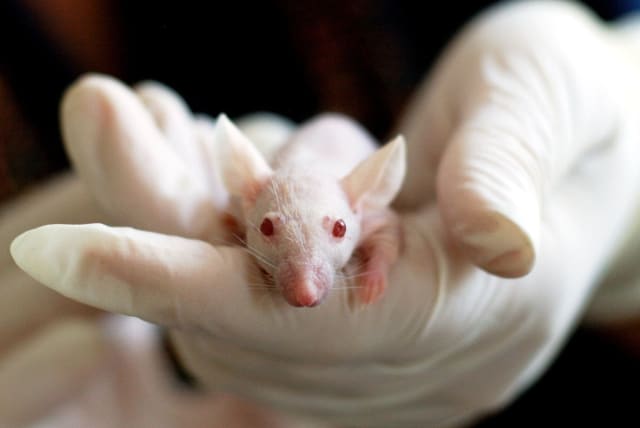Hebrew University scientists create special ‘Telomouse’ with human-like telomeres

Caps on the ends of chromosomes are critical for maintaining genetic integrity and promoting healthy aging.
Telomeres are like tiny bottle caps attached to both ends of every chromosome in your body to protect the genome from degrading and to preserve the information in them. For safeguarding our genetic material and ensuring the orderly division of our cells, their structural integrity and optimal length, they have the potential to lower the risk of cancer and to offer a healthier process of aging.
The telomeres in ordinary lab mice are about five times longer than those in humans – and this difference has presented a daunting challenge in using mice models for understanding the implications of these chromosome caps for human aging and cancer. However, despite decades of research, it was not understood how telomere length homeostasis is achieved.
But now, researchers at the Hebrew University of Jerusalem (HU) have invented the “Telomouse” by making a minuscule genetic change in standard lab mice. This causes the new telomeres to resemble those in humans more closely.
Standard lab mice have telomeres five times longer than humans, creating challenges in modeling their role in human aging and cancer. The Telomouse model, developed by incorporating a genetic variation from a mouse species with naturally shorter telomeres, provides a valuable resource for in-depth aging and cancer research, highlighting the importance of the RTEL1 protein in determining telomere length. This discovery promises to reveal new insights into the genetics of aging and may contribute to enhanced longevity and well-being.
In an exciting scientific breakthrough, a team of researchers led by Prof. Yehuda Tzfati from HU’s Institute of Life Science and Prof. Klaus Kaestner from the University of Pennsylvania Perelman School of Medicine, has introduced the Telomouse. It involves changing just one tiny building block in one gene of ordinary lab mice (Mus musculus) to make their telomeres look much more like the telomeres in humans.
They just published their findings in the prestigious journal Nature Communications under the title “Telomouse – a mouse model with human-length telomeres generated by a single amino acid change in RTEL1.”
Exercise can increase telomerase activity
Encouragingly, a 2021 review of studies in Frontiers in Genetics concluded that aerobic exercise and/or endurance training, and moderate intensity resistance training can increase the activity of telomerase and conserve telomere length.
To develop the Telomouse model, the researchers looked at a distinct mouse species called the Algerian mouse (Mus spretus or the western Mediterranean mouse), a wild species closely related to the house mouse that is native to open habitats around the western Mediterranean. This rodent is unusual by having inherently shorter telomeres.
Within the genetic code of these mice, a subtle variation within a pivotal protein known as RTEL1 was identified. By transferring this genetic distinction into typical lab mice, they succeeded in producing a lineage of mice with human-length telomeres. These novel Telomice enjoy robust health and reproductive capabilities, making them an exceptional resource for in-depth investigations into the complex realms of aging and cancer.
This study illuminates the central role of RTEL1 as the arbiter of telomere length. A nuanced modification to this crucial protein has enabled scientists to fashion a mouse model that closely approximates the human telomere length.
The researchers also achieved an invaluable breakthrough in our ability to measure the length of each single telomere, especially the shortest telomeres in the cell that are the ones to dictate the cellular function and future. They developed a novel method for measuring the precise length of individual telomeres using a new generation of DNA arrangement called nanopore sequencing. This method, termed “NanoTelSeq,” makes it possible to evaluate telomeric health in samples from blood or other tissues of healthy individuals, as well as patients of cancers and aging diseases and improve diagnosis, prognosis, and treatment of these patients.
Tzfati, who was the principal investigator, suggested that the Telomouse model “promises to enrich our comprehension of the intricate nexus between telomeres, cancer and the aging process. I believe that NanoTelSeq will replace currently used methods, enable acurate evaluation of the telomere state in patients and healthy individuals, and reveal how it affects human health. Such insights will hopefully culminate in innovative strategies for combating cancer and fostering the well-being of aging individuals.”
Jerusalem Post Store
`; document.getElementById("linkPremium").innerHTML = cont; var divWithLink = document.getElementById("premium-link"); if (divWithLink !== null && divWithLink !== 'undefined') { divWithLink.style.border = "solid 1px #cb0f3e"; divWithLink.style.textAlign = "center"; divWithLink.style.marginBottom = "15px"; divWithLink.style.marginTop = "15px"; divWithLink.style.width = "100%"; divWithLink.style.backgroundColor = "#122952"; divWithLink.style.color = "#ffffff"; divWithLink.style.lineHeight = "1.5"; } } (function (v, i) { });

